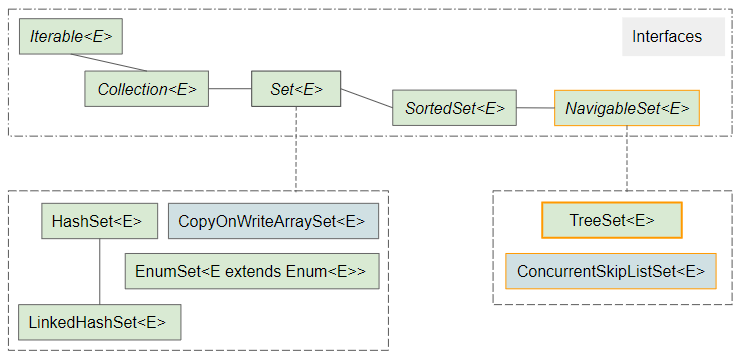Java TreeSet Tutorial with Examples
1. TreeSet
No ADS
In this article we will explore TreeSet class, which is an implementation of NavigableSet Interface and resides in Java Collection Framework.

public class TreeSet<E> extends AbstractSet<E>
implements NavigableSet<E>, Cloneable, java.io.SerializableBasically, in this article we will learn the characteristics of TreeSet and how it stores elements. You should learn the basics of Set before continuing with this article.

- Collection
- Set
- SortedSet
- NavigableSet
- ConcurrentSkipListSet
- HashSet
- LinkedHashSet
- CopyOnWriteArraySet
- EnumSet
Characteristics of TreeSet:
Set<E> | SortedSet<E> NavigableSet<E> | TreeSet<E> |
Duplicate elements are not allowed. If you intentionally add a duplicate element, this action will be ignored. | ||
At most one null element is allowed. | At most one null element is allowed and null is only allowed if a suitable Comparator is provided. | |
The order of elements is not guaranteed. | Sort elements ascendingly by their natural order or by a provided Comparator. | |
Inherit
s the characteristics of SortedSet interface. All elements of TreeSet must be Comparable type or you must provide a Comparator for TreeSet comparing the elements. Otherwise, ClassCastException will be thrown. Comparator is provided at the time TreeSet object is created through one of its constructors.
TreeSet constructors:
TreeSet(Comparator<? super E> comparator)
// Using the same ordering as the specified sortedSet.
TreeSet(SortedSet<E> sortedSet)
TreeSet()
TreeSet(Collection<? extends E> c)2. How does TreeSet store data?
No ADS
TreeSet<E> manages an internal TreeMap<E,Object> object - internalMap. All operations on TreeSet are performed on internalMap. In addition, as we know TreeMap stores its data in a tree structure, which is the reason for the name of TreeSet.

For ease of understanding, look at the source code of java.util.TreeSet class, you'll see that it acts like a delegate of TreeMap object it manages.
java.util.TreeSet class
public class TreeSet<E> extends AbstractSet<E>
implements NavigableSet<E>, Cloneable, java.io.Serializable {
private static final Object PRESENT = new Object();
private transient TreeMap<E,Object> internalMap;
public boolean add(E e) {
return this.internalMap.put(e, PRESENT)==null;
}
public boolean remove(Object o) {
return this.internalMap.remove(o)==PRESENT;
}
public void clear() {
this.internalMap.clear();
}
public E first() {
return this.internalMap.firstKey();
}
public E last() {
return this.internalMap.lastKey();
}
// Other methods..
}TreeMap stores its data in a tree structure, which is explained in my article below. Check it out if you are interested.
3. Examples
No ADS
As we all know, Integer class implements Comparable interface, so Integer objects can be compared with each other. TreeSet with elements of Integer type is not necessary to provide a Comparator.
TreeSetEx1.java
package org.o7planning.treeset.ex;
import java.util.TreeSet;
public class TreeSetEx1 {
public static void main(String[] args) {
TreeSet<Integer> set = new TreeSet<>();
//
set.add(5);
set.add(3);
set.add(9);
set.add(7);
set.add(1);
set.add(11);
System.out.println(set);
}
}Output:
[1, 3, 5, 7, 9, 11]Example: Use custom Comparator to reverse elements order.
TreeSet_reverseOrder_ex1.java
package org.o7planning.treeset.ex;
import java.util.Comparator;
import java.util.TreeSet;
public class TreeSet_reverseOrder_ex1 {
public static void main(String[] args) {
Comparator<Integer> reverseOrderComparator = Comparator.reverseOrder();
TreeSet<Integer> set = new TreeSet<>(reverseOrderComparator);
//
set.add(5);
set.add(3);
set.add(9);
set.add(7);
set.add(1);
set.add(11);
System.out.println(set);
}
}Output:
[11, 9, 7, 5, 3, 1]See more examples of using custom Comparator in TreeSet and how to navigate and find elements.
- NavigableSet
- SortedSet
- Comparator
4. TreeSet with null element
No ADS
TreeSet allows null element only if it is provided with a Comparator that supports the comparison of null element with other elements.
TreeSet_nullElement_ex1.java
package org.o7planning.treeset.ex;
import java.util.Comparator;
import java.util.SortedSet;
import java.util.TreeSet;
public class TreeSet_nullElement_ex1 {
public static void main(String[] args) {
// Comparator.nullsFirst
// Comparator.nullsLast
Comparator<String> comparator = Comparator.nullsFirst(Comparator.naturalOrder());
// Create a SortedSet object.
SortedSet<String> map = new TreeSet<String>(comparator);
map.add("B");
map.add("A");
map.add("F");
map.add(null);
map.add("D");
map.add("E");
System.out.println(map);
}
}Output:
[null, A, B, D, E, F]Example: Write a custom Comparator that supports comparing null element with other elements:
TreeSet_nullElement_ex2.java
package org.o7planning.treeset.ex;
import java.util.Comparator;
import java.util.SortedSet;
import java.util.TreeSet;
public class TreeSet_nullElement_ex2 {
public static void main(String[] args) {
Comparator<String> comparator = new StringNullComparator();
// Create a SortedSet object.
SortedSet<String> map = new TreeSet<String>(comparator);
map.add("B");
map.add("A");
map.add("F");
map.add(null);
map.add("D");
map.add("E");
System.out.println(map);
}
}
// The comparator supports null comparison.
class StringNullComparator implements Comparator<String> {
@Override
public int compare(String o1, String o2) {
if (o1 == o2) {
return 0; // o1 = o2
}
if (o1 == null) {
return -1; // o1 < o2
}
if (o2 == null) {
return 1; // o1 > o2
}
return o1.compareTo(o2);
}
}Output:
[null, A, B, D, E, F]No ADS
Java Collections Framework Tutorials
- Java PriorityBlockingQueue Tutorial with Examples
- Java Collections Framework Tutorial with Examples
- Java SortedSet Tutorial with Examples
- Java List Tutorial with Examples
- Java Iterator Tutorial with Examples
- Java NavigableSet Tutorial with Examples
- Java ListIterator Tutorial with Examples
- Java ArrayList Tutorial with Examples
- Java CopyOnWriteArrayList Tutorial with Examples
- Java LinkedList Tutorial with Examples
- Java Set Tutorial with Examples
- Java TreeSet Tutorial with Examples
- Java CopyOnWriteArraySet Tutorial with Examples
- Java Queue Tutorial with Examples
- Java Deque Tutorial with Examples
- Java IdentityHashMap Tutorial with Examples
- Java WeakHashMap Tutorial with Examples
- Java Map Tutorial with Examples
- Java SortedMap Tutorial with Examples
- Java NavigableMap Tutorial with Examples
- Java HashMap Tutorial with Examples
- Java TreeMap Tutorial with Examples
- Java PriorityQueue Tutorial with Examples
- Java BlockingQueue Tutorial with Examples
- Java ArrayBlockingQueue Tutorial with Examples
- Java TransferQueue Tutorial with Examples
Show More